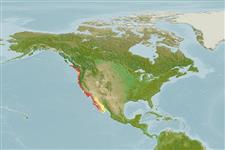Classification / Names
Common names from other countries
Main reference
Size / Weight / Age
Max length : 24.8 cm SL male/unsexed; (Ref. 27436); common length : 15.0 cm TL male/unsexed; (Ref. 9988); max. published weight: 68.00 g (Ref. 56527); max. reported age: 7 years (Ref. 6884)
Length at first maturity
Lm 9.6 range ? - ? cm
Environment
Marine; pelagic-neritic; depth range 0 - 310 m (Ref. 96339), usually ? - 219 m (Ref. 54433)
Climate / Range
Subtropical, preferred 13°C (Ref. 107945); 51°N - 21°N, 131°W - 108°W (Ref. 54433)
Distribution
Northeast Pacific: northern Vancouver Island south to Cape San Lucas, Baja California, Mexico. Two subspecies recognized: Engraulis mordax mordax from British Columbia to Baja California and Engraulis mordax nanus in Bays of California.
Countries | FAO areas | Ecosystems | Occurrences | Introductions
Short description
Dorsal
spines
(total): 0;
Dorsal
soft rays
(total): 14-19;
Anal
spines: 0;
Anal
soft rays: 19 - 26;
Vertebrae: 43 - 47. Snout quite sharply pointed; maxilla moderate, tip sharply pointed, reaching to or almost to hind border of pre-operculum, projecting well beyond tip of second supra-maxilla; tip of lower jaw below nostril. gill rakers slender, long; absent on hind face of third epibranchial. Anal fin origin under about base of last dorsal fin ray. A silver stripe along flank, disappearing with age.
IUCN Red List Status (Ref. 115185)
Threat to humans
Harmless
Human uses
Fisheries: commercial; bait: usually
Tools
Special reports
Download XML
Internet sources
Estimates of some properties based on models
Phylogenetic diversity index
PD50 = 0.5020 many relatives (e.g. carps) 0.5 - 2.0 few relatives (e.g. lungfishes)
Trophic Level
3.1 ±0.28 se; Based on food items.
Resilience
Medium, minimum population doubling time 1.4 - 4.4 years (rm=0.36; K=0.2-0.6; tm=1-4; tmax=7; Fec=4000)
Vulnerability
Low to moderate vulnerability (30 of 100)
Price category
